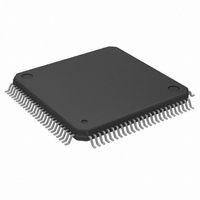M306N5FCTFP Renesas Electronics America, M306N5FCTFP Datasheet - Page 15

M306N5FCTFP
Manufacturer Part Number
M306N5FCTFP
Description
IC M16C MCU FLASH 100QFP
Manufacturer
Renesas Electronics America
Series
M16C™ M16C/6Nr
Datasheets
1.M30622SAFPU5.pdf
(308 pages)
2.M306N5FCTFPUK.pdf
(90 pages)
3.M306N5FCTFPU0.pdf
(408 pages)
Specifications of M306N5FCTFP
Core Processor
M16C/60
Core Size
16-Bit
Speed
20MHz
Connectivity
CAN, I²C, IEBus, SIO, UART/USART
Peripherals
DMA, WDT
Number Of I /o
87
Program Memory Size
128KB (128K x 8)
Program Memory Type
FLASH
Ram Size
5K x 8
Voltage - Supply (vcc/vdd)
4.2 V ~ 5.5 V
Data Converters
A/D 26x10b; D/A 2x8b
Oscillator Type
Internal
Operating Temperature
-40°C ~ 85°C
Package / Case
100-QFP
Lead Free Status / RoHS Status
Contains lead / RoHS non-compliant
Eeprom Size
-
Available stocks
Company
Part Number
Manufacturer
Quantity
Price
Company:
Part Number:
M306N5FCTFP
Manufacturer:
ON
Quantity:
36 000
Company:
Part Number:
M306N5FCTFP#U0
Manufacturer:
Renesas Electronics America
Quantity:
10 000
Company:
Part Number:
M306N5FCTFP#UK
Manufacturer:
XILINX
Quantity:
1 400
Company:
Part Number:
M306N5FCTFP#UK
Manufacturer:
Renesas Electronics America
Quantity:
135
Company:
Part Number:
M306N5FCTFP#UK
Manufacturer:
Renesas Electronics America
Quantity:
10 000
Company:
Part Number:
M306N5FCTFP#UKJ
Manufacturer:
Renesas Electronics America
Quantity:
10 000
M16C/6N Group (M16C/6N5)
Rev.2.40
REJ03B0004-0240
Under development
This document is under development and its contents are subject to change.
2.3 Frame Base Register (FB)
2.4 Interrupt Table Register (INTB)
2.5 Program Counter (PC)
2.6 User Stack Pointer (USP), Interrupt Stack Pointer (ISP)
2.7 Static Base Register (SB)
2.8 Flag Register (FLG)
FB is configured with 16 bits, and is used for FB relative addressing.
INTB is configured with 20 bits, indicating the start address of an interrupt vector table.
PC is configured with 20 bits, indicating the address of an instruction to be executed.
Stack pointer (SP) comes in two types: USP and ISP, each configured with 16 bits.
Your desired type of stack pointer (USP or ISP) can be selected by the U flag of FLG.
SB is configured with 16 bits, and is used for SB relative addressing.
FLG consists of 11 bits, indicating the CPU status.
2.8.1 Carry Flag (C Flag)
2.8.2 Debug Flag (D Flag)
2.8.3 Zero Flag (Z Flag)
2.8.4 Sign Flag (S Flag)
2.8.5 Register Bank Select Flag (B Flag)
2.8.6 Overflow Flag (O Flag)
2.8.7 Interrupt Enable Flag (I Flag)
2.8.8 Stack Pointer Select Flag (U Flag)
2.8.9 Processor Interrupt Priority Level (IPL)
2.8.10 Reserved Area
This flag retains a carry, borrow, or shift-out bit that has occurred in the arithmetic/logic unit.
This flag is used exclusively for debugging purpose. During normal use, set to 0.
This flag is set to 1 when an arithmetic operation resulted in 0; otherwise, it is 0.
This flag is set to 1 when an arithmetic operation resulted in a negative value; otherwise, it is 0.
Register bank 0 is selected when this flag is 0; register bank 1 is selected when this flag is 1.
This flag is set to 1 when the operation resulted in an overflow; otherwise, it is 0.
This flag enables a maskable interrupt.
Maskable interrupts are disabled when the I flag is 0, and are enabled when the I flag is 1. The I flag is set
to 0 when the interrupt request is accepted.
ISP is selected when the U flag is 0; USP is selected when the U flag is 1.
The U flag is set to 0 when a hardware interrupt request is accepted or an INT instruction for software
interrupt Nos. 0 to 31 is executed.
IPL is configured with three bits, for specification of up to eight processor interrupt priority levels from level
0 to level 7.
If a requested interrupt has priority greater than IPL, the interrupt request is enabled.
When white to this bit, write 0. When read, its content is undefined.
Aug 25, 2006
page 13 of 84
2. Central Processing Unit (CPU)

























